Lepiota brunneoincarnata: a toxic lepiota to be aware of
3 years ago · Updated 6 months ago
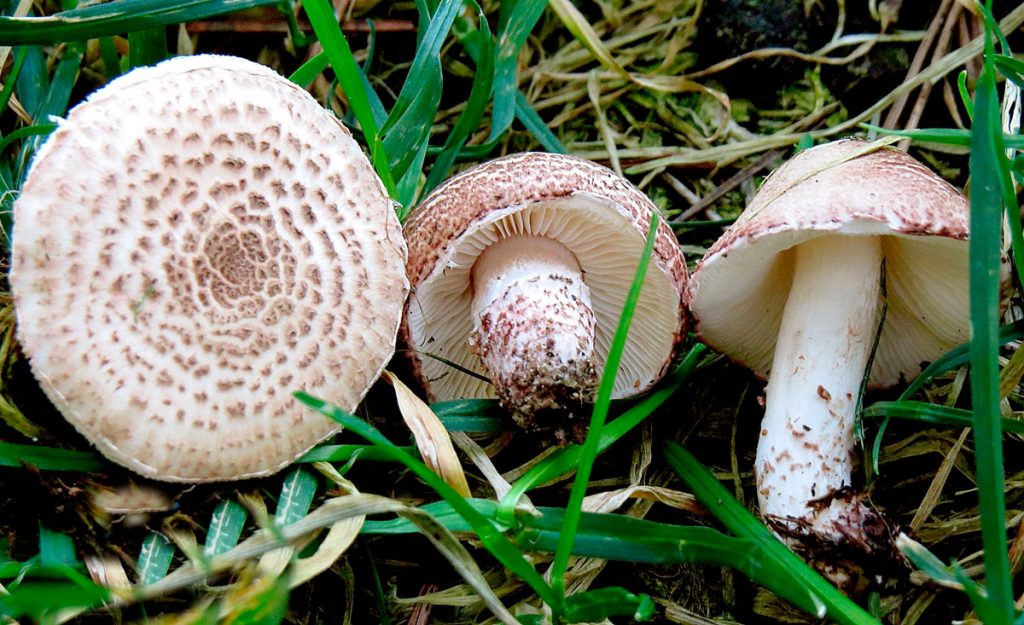
Lepiota brunneoincarnata, a dangerous mushroom, small but very dangerous.
Even more important than knowing which mushrooms are edible is knowing which ones can cause us serious harm. Even death. We want to show you what poisonous mushrooms look like, including the one that causes the most problems year after year, Lepiota brunneoincarnata.
Lepiota brunneoincarnata is a small mushroom species but is highly toxic. It is important to recognize it and exercise caution when encountering it in the wild. In this article, we will explore its physical characteristics, habitat, and the importance of avoiding consumption.
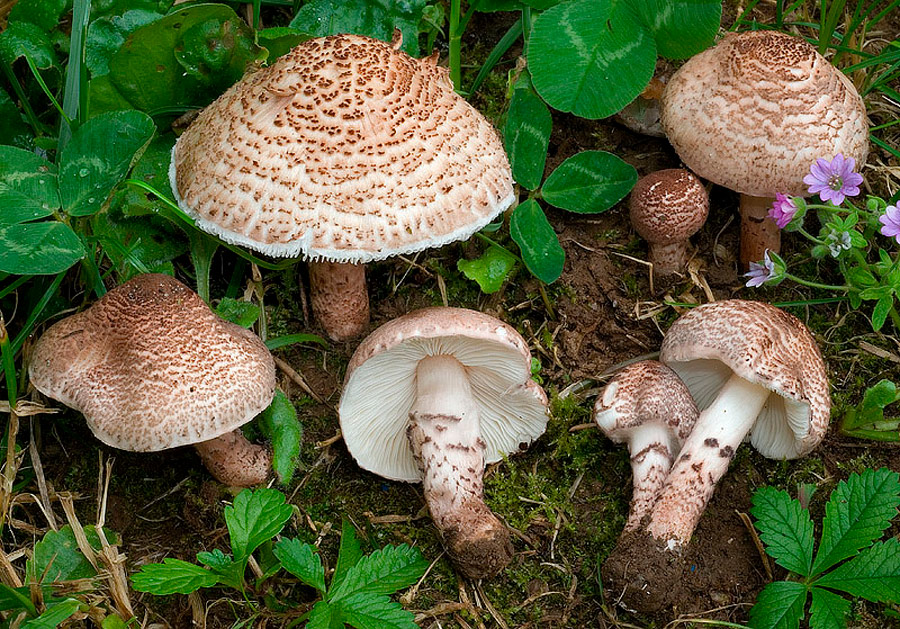
Lepiota bruneoincarnata, How to distinguish it?
This small mushroom has a cap with a maximum diameter of 3 to 5 cm. Initially, its shape is somewhat globular, then becomes convex and flattened, without a nipple. The cuticle is dry and cream-colored, with concentric scales of a wine-brown color, except in the center, where it remains smooth and brown.
The stem of Lepiota brunneoincarnata is cylindrical, of medium thickness and hollow. Above the ring, it is smooth and white, while below it has wine-brown scales. The ring is narrow and fleeting, brownish in color. The stem can be easily separated from the mushroom. It is important to note that its ring is fleeting and not permanent.
The gills of this poisonous lepiota are thin and free, with tightly packed white lamellae when young, turning creamy in color as they mature. The flesh of Lepiota brunneoincarnata is thick in the center, white in color, and reddens under the cuticle. It has a faint odor and a mild flavor.
Taxonomically, Lepiota brunneoincarnata belongs to the Agaricaceae family, subclass Agaricomycetes, order Agaricales, and class Basidiomycotina. It also has a few synonyms, such as Lepiota patouillardii, Lepiota barleana, and Lepiota barlae. Among its common names is “reddish brown lepiota.” In terms of practical importance and gastronomic interest, it is considered a poisonous mushroom and unfit for human consumption.
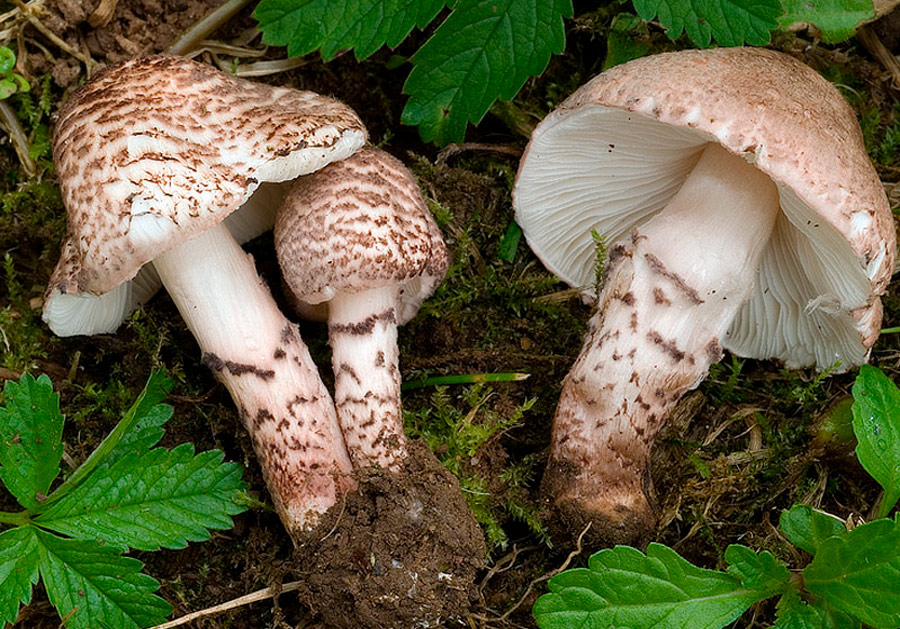
Habitat of Lepiota brunneoincarnata
Lepiota brunneoincarnata is a highly toxic mushroom found in specific habitats during the summer and fall months. It has been observed in meadows, parks, gardens, brush, and along roadsides. Although it was originally thought to prefer heliophilous habitats, its growth has been recorded in both sunny areas and in the shade of conifers such as the common spruce (Picea abies) and Douglas fir (Pseudotsuga menziesii).
Season of appearance of Lepiota Bruneoincarnata
L. Bruneoincarnata, also known as brown-fleshed Lepiota, is a poisonous and deadly species of mushroom that deserves our attention. As for its season of appearance, we can find this mushroom during the summer and fall months.
> 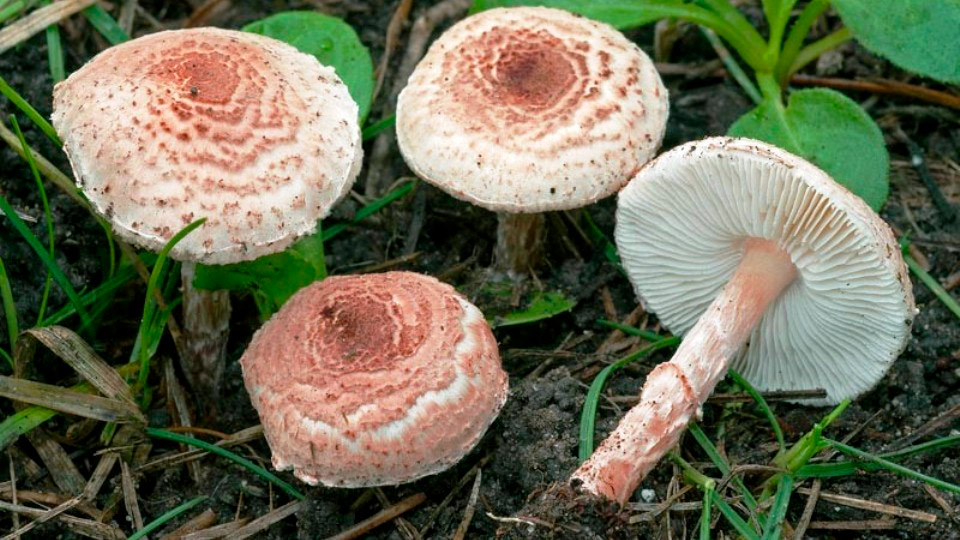
Poisonous lepiota mushrooms: caution!
It is essential to exercise caution when picking mushrooms in general, and especially when encountering poisonous species such as poisonous lepiota mushrooms, particularly the brown-incarnate lepiota. It is often confused with other small, scaly mushrooms, as well as with certain species of the Agaricus genus that have reddish tones. Therefore, it is crucial to have the necessary knowledge or to consult mycological experts to avoid any risk.
In summary, Lepiota brunneoincarnata may be a tiny mushroom, but its toxicity is extremely dangerous. It should never be eaten, as it can cause severe poisoning and even death. Remember that it is more important to protect our health and enjoy nature safely than to risk it for a mushroom.
Confusion of Lepiota bruneoincarnata with other lepiota mushrooms
We should never harvest lepiota mushrooms smaller than 7-8 cm, as they will be toxic in most cases. In these cases, the morphological differences from other edible Lepiota mushrooms are very slight and the likelihood of fatal confusion is very, very high. It's not that they are poisonous, it's that if we make a mistake, we have a serious problem: they are DEADLY. So take note:
Never pick lepiota mushrooms less than 7 cm tall unless you want to risk your life
Poisonous lepiota mushrooms? No! Deadly lepiota mushrooms. Be very careful with them
Lepiota venenata

Macrolepiota venenata is a deadly mushroom that can be distinguished by its specific characteristics. Its cap has a diameter ranging from 6 to 24 cm and is initially convex in shape, later spreading out with a broad, slightly pronounced irregular bulge. The cuticle is smooth at first and pinkish-brown in color, but quickly breaks into large dark brown scales with soft, spongy white lacerations that form a characteristic disordered pattern, then a radial and concentric pattern. The disc area, clearly defined, is similar in color to the scales but slightly darker. The edge of the cap is protruding and the margin is almost free of scales.
The gills of Macrolepiota venenata are crowded, bulbous and free. They are creamy white in color, turning pinkish or pinkish brown when rubbed, even reaching a wine red color.
The stem of this mushroom can be 6 to 12 cm long and 1 to 2.5 cm thick. It is thin and cylindrical, sometimes slightly wider at the base, and has a large bulb. The stem is smooth, fibrous, and hollow. Above the ring, it is light brown in color and below the ring, it is darker, turning reddish brown when rubbed, especially at the junction with the cap. Its ring is simple and breaks if moved, unlike that of the edible mushroom (procera), whose ring rises and falls along the stem without breaking.
The flesh of M. venenata is very soft and white at first, but darkens when cut and takes on reddish-brown tones.
This mushroom is uncommon and usually grows in clusters, meaning that several specimens emerge from the same stipe. Unlike other macrolepiotas, more than one individual never grows from the same stipe. It can be found associated with false nettles and usually fruits in areas rich in organic matter, such as manure piles or mounds of waste.
It is important to note that Macrolepiota venenata is poisonous or indigestible, causing gastrointestinal disorders. Symptoms include nausea, malaise, vomiting, abdominal pain, and diarrhea. Dehydration can be a complication due to significant fluid loss, so it is necessary to treat it early on.
Observations: This species, Macrolepiota venenata, is poisonous and very similar to Macrolepiota rhacodes, but unlike the latter, Macrolepiota venenata has a bulbous base at the stem and its cap breaks up into large, star-shaped scales. It also usually grows in dense clusters in highly fertilized areas.
Lepiota helveola
The dangerous and deadly Lepiota helveola, also known as the “spring grey mushroom,” is a fungus that deserves our attention and caution due to its particular characteristics. The cap of Lepiota helveola has a diameter of between 2 and 7 centimeters, and it is crucial to take this information into account to avoid confusion with macro-Lepiota species. In its early stage, it has a conical-bell-shaped form that later becomes bell-shaped-convex, and finally spreads out or curves slightly upward, forming almost a nipple. Its color varies from light brown to reddish brown and is covered with darker scales, while the edge is hairy, except in the central area of the cap, which remains smooth.
The gills of Lepiota helveola are free and dense, but as the mushroom ages, they become more spaced out. When mature, these gills are white and have small hairs on the edge.
Unlike macrolepiota mushrooms, the stem is no longer than 5 centimeters and 0.3 to 0.8 centimeters thick. It is fragile, covered with hairs when young and eventually becomes hollow, retaining the same color as the cap and showing scales below the ring. The ring, which is thin and membranous, is brown or reddish-brown in color and tends to disappear easily.
The flesh of Lepiota helveola is white and tends to turn red, especially when dried or rubbed, and has a slight floury smell. Its taste is bland.
This species is found in autumn on the edges of forests and paths. However, it is important to note that Lepiota helveola is highly toxic and can be fatal. It contains the same toxins as Amanita phalloides, so it is essential to exercise caution and avoid consumption. Unfortunately, every year we hear tragic news about this species, so it is important to take note and be aware of its danger.
Edible Lepiota mushrooms
Macrolepiota rhacodes
Macrolepiota rhacodes, also known as the “devouring mushroom,” is a fascinating mushroom that deserves our attention. Its cap undergoes various changes during its development: initially hemispherical or conical, it then becomes convex and finally spreads out, without forming a nipple as is the case with M. procera. Its diameter ranges from 5 to 15 centimeters. The surface of the cap is covered with a fine grayish down and has large brown scales that are slightly raised.
Its flesh is white and turns reddish when cut, which is important information for distinguishing it from other species.
The gills of Macrolepiota rhacodes are white, uneven, and free, turning red when rubbed.
The stem of this mushroom is elongated, grayish ochre in color, tending to be lighter. It has a movable ring and a bulbous base.
In terms of habitat, it can be found in summer and fall, mainly in coniferous forests, but also in deciduous forests.
It is important to mention that Macrolepiota rhacodes is considered to be of the same culinary quality as Macrolepiota procera. However, it can be confused with other lepiota mushrooms whose flesh also turns red and which can cause mild poisoning, such as Macrolepiota venenata, which has a cap with a large brown central area that is smooth and has a star-shaped pattern. In general, this species appears in places with abundant organic matter or dry grass.
In summary, Macrolepiota rhacodes is an interesting and versatile mushroom that deserves to be known and appreciated in its natural environment.
Macrolepiota excoriata
Lepiota edible, also known as “galliperno,” “apagador excoriado,” “apagador blanco,” or “galanperna erdizuritu,” is a mushroom that deserves to be highlighted. Its cap can reach 4 to 12 centimeters in diameter. At first, it is closed and conical in shape, becoming convex and finally flattening with a slight nipple. The surface of the cap is covered with scales, which are rarer at the edges, forming a star-shaped pattern of cracks from the margin. Its color varies between cream and hazelnut, with a rather whitish background. The edge of the cap is protruding, irregular, and hanging.
The gills of Macrolepiota excoriata are abundant, numerous, and very close together. They are thin, white, and turn beige with age.
The stem of this species is cylindrical and slender, with a volva-shaped base. It is smooth and whitish to beige in color. It has a single, membranous, persistent ring on the stem.
The flesh of Macrolepiota excoriata is thin and tender in the cap, but fibrous in the stem. It is white in color, with a sweetish taste and a pleasant smell.
This mushroom can be found in autumn and spring in various habitats such as meadows and dehesas.
As for its edibility, Macrolepiota excoriata is considered an edible species, especially the caps of specimens that are not yet fully open and young specimens that are fully open, as is the case with other macrolepiotas.
One of the main characteristics of Macrolepiota excoriata is that its cuticle tears in a star shape and has scales on the edges. It can sometimes be confused with Macrolepiota mastoidea, which is distinguished by a sharp, nipple-shaped protuberance.
In summary, Macrolepiota excoriata is an interesting medium-sized mushroom with a distinctive and edible cuticle that deserves to be recognized and appreciated in its natural environment.
Macrolepiota mastoidea
Also known as “hammock mushroom,” “parasol mushroom,” “galanperna puntadun,” “maluta puntaduna,” “apagallus,” or “campanillas,” this is a fascinating mushroom to explore. Its cap is medium-sized and can measure up to 14 centimeters in diameter. In its early stages, it has a conical or globular shape and then widens to take on a bell shape. Finally, it becomes flat and spread out, always retaining a characteristic pointed nipple.
The cuticle of Macrolepiota mastoidea is cream-colored, turning brown as it matures, with small, darker scales distributed randomly. In the center of the cap, the nipple is dark brown, and the cuticle separates easily from the flesh. In its early stages, the cuticle is cream-gray and almost uniform, but as it grows, it opens into scales, revealing the appearance mentioned above. The edge of the cap is irregular, with sharp fringes that evolve into a scalloped, cottony edge that is always protruding.
The gills of Macrolepiota mastoidea are clearly free, soft in appearance, moderately broad but slightly bulbous, and very crowded. They are white in color, becoming gently cream with the presence of lamellulae. The gill edges are smooth and thin. In the very mature stage, rust-colored areas may appear.
The stem of this species is central, cylindrical, hollow, and fibrous. It is straight and slender in relation to the cap, reaching up to 18 centimeters in length and 0.5 to 1 centimeter in diameter.
A noticeable bulb develops at the base of the stem, tapering towards the apex. The color of the stem is whitish and it is finely covered with a kind of brownish-cream felt, more visible in the upper part. It separates from the cap as an independent entity. The ring is membranous, located in the upper part of the stem, simple, initially fixed and then easily detached. It is slippery and white on the upper surface and ochre on the lower surface.
The flesh of Macrolepiota mastoidea is whitish in color, with a soft and thick texture in the cap, but thin in the stem. Although rare in relation to its size, it has a fungal smell and a very pleasant, mild flavor. The stem is fibrous and not very firm.
This species can be found in autumn in various habitats, such as clearings in all types of forests, along paths, or in pastures. Although it is quite common, it disappears when the first cold weather arrives. It can be found individually or in small groups.
As for its edibility, Macrolepiota mastoidea is considered good to eat, although its flesh is a little sparse compared to other macrolepiotas. However, cases of mild allergic-type digestive disorders have been reported.
In summary, Macrolepiota mastoidea is a medium-sized mushroom with a distinctive cap that has a pointed nipple. Its appearance and characteristics make it an interesting species for mycology enthusiasts, although care should be taken to distinguish it from other similar species.
Health and caution with poisonous lepiota mushrooms!


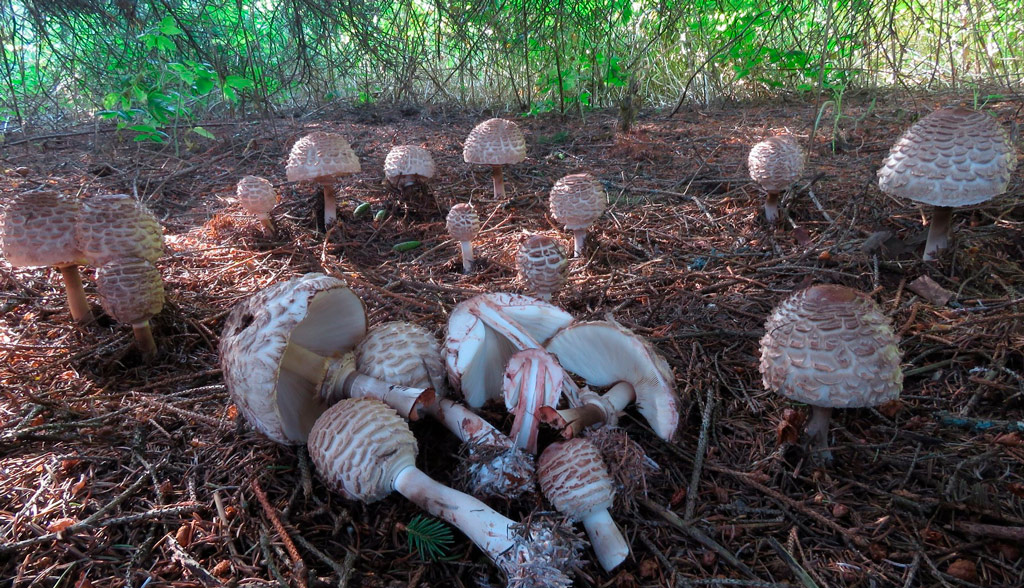
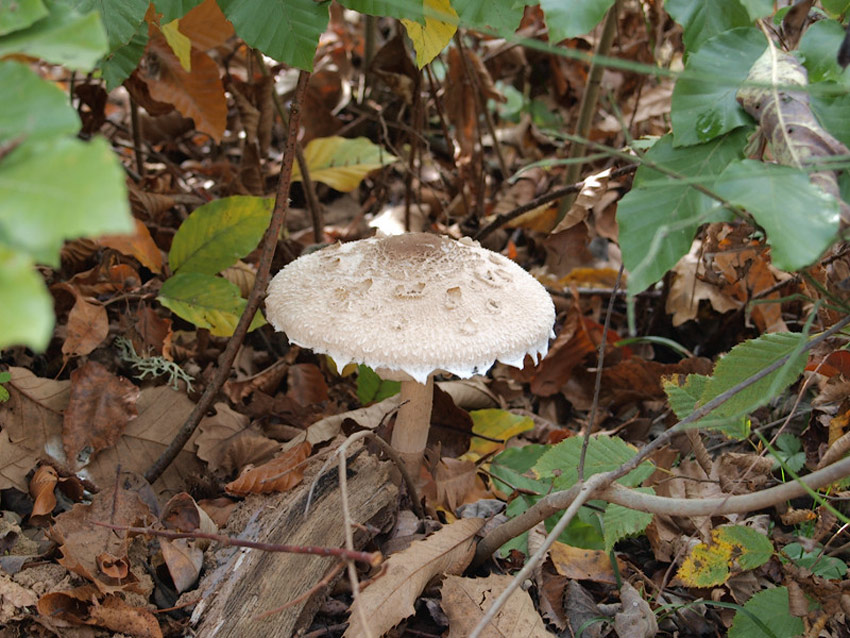
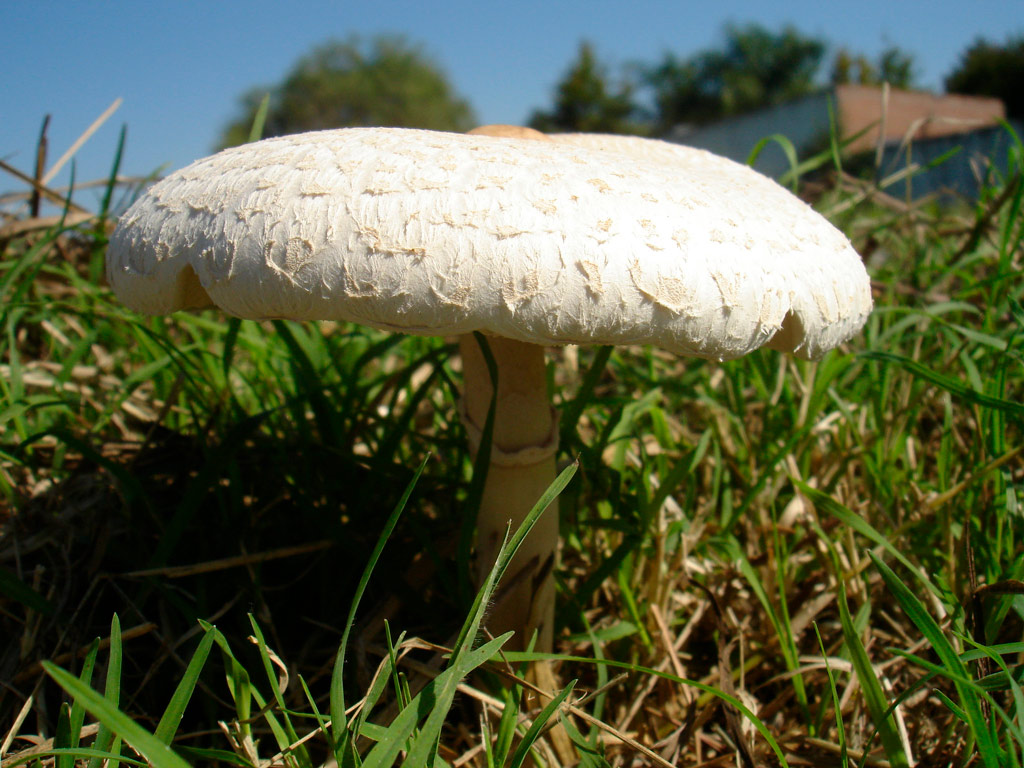
Te pueden interesar